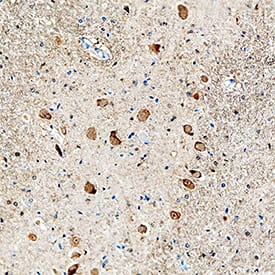Human FGF acidic/FGF1 Antibody
R&D Systems, part of Bio-Techne | Catalog # MAB2321

Key Product Details
Species Reactivity
Applications
Label
Antibody Source
Product Specifications
Immunogen
Phe16-Asp155
Accession # P05230
Specificity
Clonality
Host
Isotype
Scientific Data Images for Human FGF acidic/FGF1 Antibody
Detection of Human FGF acidic/FGF1 by Western Blot.
Western blot shows lysates of human brain (hypothalamus) tissue and human heart tissue. PVDF membrane was probed with 1 µg/mL of Mouse Anti-Human FGF acidic/FGF1 Monoclonal Antibody (Catalog # MAB2321) followed by HRP-conjugated Anti-Mouse IgG Secondary Antibody (Catalog # HAF018). Specific bands were detected for FGF acidic/FGF1 at approximately 16-17 kDa (as indicated). This experiment was conducted under reducing conditions and using Immunoblot Buffer Group 1.FGF acidic/FGF1 in Human Brain.
FGF acidic/FGF1 was detected in immersion fixed paraffin-embedded sections of human brain using Mouse Anti-Human FGF acidic/FGF1 Monoclonal Antibody (Catalog # MAB2321) at 5 µg/mL overnight at 4 °C. Tissue was stained using the Anti-Mouse HRP-DAB Cell & Tissue Staining Kit (brown; Catalog # CTS002) and counterstained with hematoxylin (blue). Specific staining was localized to neuronal cytoplasm. View our protocol for Chromogenic IHC Staining of Paraffin-embedded Tissue Sections.Applications for Human FGF acidic/FGF1 Antibody
Immunohistochemistry
Sample: Immersion fixed paraffin-embedded sections of human brain
Western Blot
Sample: Human brain (hypothalamus) tissue and human heart tissue
Reviewed Applications
Read 1 review rated 5 using MAB2321 in the following applications:
Formulation, Preparation, and Storage
Purification
Reconstitution
Formulation
Shipping
Stability & Storage
- 12 months from date of receipt, -20 to -70 °C as supplied.
- 1 month, 2 to 8 °C under sterile conditions after reconstitution.
- 6 months, -20 to -70 °C under sterile conditions after reconstitution.
Background: FGF acidic/FGF1
FGF acidic, also known as FGF1, ECGF, and HBGF-1, is a 17 kDa nonglycosylated member of the FGF family of mitogenic peptides. FGF acidic, which is produced by multiple cell types, stimulates the proliferation of all cells of mesodermal origin and many cells of neuroectodermal, ectodermal, and endodermal origin. It plays a number of roles in development, regeneration, and angiogenesis (1-3). Human FGF acidic shares 54% amino acid sequence identity with FGF basic and 17%‑33% with other human FGFs. It shares 92%, 96%, 96%, and 96% aa sequence identity with bovine, mouse, porcine, and rat FGF acidic, respectively, and exhibits considerable species cross-reactivity. Alternate splicing generates a truncated isoform of human FGF acidic that consists of the N-terminal 40% of the molecule and functions as a receptor antagonist (4). During its nonclassical secretion, FGF acidic associates with S100A13, copper ions, and the C2A domain of synaptotagmin 1 (5). It is released extracellularly as a disulfide-linked homodimer and is stored in complex with extracellular heparan sulfate (6). The ability of heparan sulfate to bind FGF acidic is determined by its pattern of sulfation, and alterations in this pattern during embryogenesis thereby regulate FGF acidic bioactivity (7). The association of FGF acidic with heparan sulfate is a prerequisite for its subsequent interaction with FGF receptors (8, 9). Ligation triggers receptor dimerization, transphosphorylation, and internalization of receptor/FGF complexes (10). Internalized FGF acidic can translocate to the cytosol with the assistance of Hsp90 and then migrate to the nucleus by means of its two nuclear localization signals (11-13). The phosphorylation of FGF acidic by nuclear PKC delta triggers its active export to the cytosol where it is dephosphorylated and degraded (14, 15). Intracellular FGF acidic functions as a survival factor by inhibiting p53 activity and proapoptotic signaling (16).
References
- Jaye, M. et al. (1986) Science 233:541.
- Galzie, Z. et al. (1997) Biochem. Cell Biol. 75:669.
- Presta, M. et al. (2005) Cytokine Growth Factor Rev. 16:159.
- Yu, Y.L. et al. (1992) J. Exp. Med. 175:1073.
- Rajalingam, D. et al. (2007) Biochemistry 46:9225.
- Guerrini, M. et al. (2007) Curr. Pharm. Des. 13:2045.
- Allen, B.L. and A.C. Rapraeger (2003) J. Cell Biol. 163:637.
- Robinson, C.J. et al. (2005) J. Biol. Chem. 280:42274.
- Mohammadi, M. et al. (2005) Cytokine Growth Factor Rev. 16:107.
- Wiedlocha, A. and V. Sorensen (2004) Curr. Top. Microbiol. Immunol. 286:45.
- Wesche, J. et al. (2006) J. Biol. Chem. 281:11405.
- Imamura, T. et al. (1990) Science 249:1567.
- Wesche, J. et al. (2005) Biochemistry 44:6071.
- Wiedlocha, A. et al. (2005) Mol. Biol. Cell 16:794.
- Nilsen, T. et al. (2007) J. Biol. Chem. 282:26245.
- Bouleau, S. et al. (2005) Oncogene 24:7839.
Long Name
Alternate Names
Gene Symbol
UniProt
Additional FGF acidic/FGF1 Products
Product Documents for Human FGF acidic/FGF1 Antibody
Product Specific Notices for Human FGF acidic/FGF1 Antibody
For research use only

